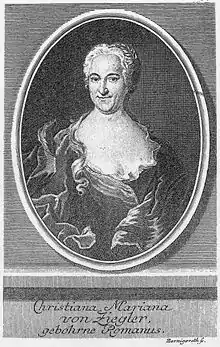Christiana Mariana von Ziegler
Christiana Mariana von Ziegler (28 June 1695 – 1 May 1760) was a German poet and writer. She is best known for the texts of nine cantatas, which Johann Sebastian Bach composed after Easter of 1725.[1]

Biography
Christiana Mariana Romanus was born in Leipzig, where her father served as mayor in 1701. She began her literary career after the death of her second husband, Captain von Ziegler in 1722. She returned to Leipzig, where she lived in the family home, the Romanushaus, with her mother. Her father had received a long-term prison sentence for financial irregularities. Despite the difficult family circumstances, the house became a literary and musical salon. Johann Christoph Gottsched encouraged her poetic activity. She became the first woman member of Gottsched's literary society, the Deutsche Gesellschaft.
In 1741 she married for the third time and her literary activity ceased.
She died in Frankfurt an der Oder.
Libretti

Bach moved to Leipzig in 1723 to take up the post of Thomaskantor. In this role he set about composing a large number of cantatas for performance in the city's churches. There is some uncertainty about who was writing Bach's libretti in his first couple of years in Leipzig.[2] Whoever his original librettist was, Bach appears to have been looking for a new librettist in 1724, and this may be when he met Ziegler.[3] The nine cantatas set by Bach to texts by Ziegler are:
- Ihr werdet weinen und heulen, BWV 103, 22 April 1725
- Es ist euch gut, daß ich hingehe, BWV 108, 29 April 1725
- Bisher habt ihr nichts gebeten in meinem Namen, BWV 87, 6 May 1725
- Auf Christi Himmelfahrt allein, BWV 128, 10 May 1725
- Sie werden euch in den Bann tun, BWV 183, 13 May 1725
- Wer mich liebet, der wird mein Wort halten, BWV 74, 20 May 1725[3]
- Also hat Gott die Welt geliebt, BWV 68, 21 May 1725
- Er rufet seinen Schafen mit Namen, BWV 175, 22 May 1725
- Es ist ein trotzig und verzagt Ding, BWV 176, 27 May 1725
The question arises why Bach turned to other librettists. There were still texts by Ziegler unset. She published a cycle of cantata texts in 1728, the texts set by Bach and others not set by him.[4] John Eliot Gardiner suggests that the relationship between the two may have been strained by Bach's habit of amending her texts to suit his purposes.[5] There also seem to be some examples of lack of communication when Bach sets Ziegler's words by adapting music he had composed earlier (as for example in Er rufet seinen Schafen mit Namen, BWV 175).[6]
Bibliography
- Vermischte Schriften in gebundener und ungebunder Rede [Miscellaneous writings in verse and prose] (1739)
References
- Christiane Mariane von Ziegler (Librettist) - Short Biography
- Wolff, Christoph. The transition between the second and the third yearly cycle of Bach's Leipzig cantatas (1725) (PDF). pregardien.com. p. 2. Archived from the original (PDF) on 2011-07-26. Retrieved 2017-08-06.
- Gardiner, John Eliot (2006). "Cantatas for Whit Monday / Holy Trinity, Long Melford" (PDF). bach-cantatas.com. pp. 10–12. Retrieved 2017-08-06.
- Versuche in gebundener und ungebundener Schreibart (Leipzig 1728)
- The versions published by Ziegler are slightly different from the texts used in the cantatas, and this is believed to be the result of the composer modifying the libretti with which he was presented. See Gardiner, John Eliot. Bach: Music in the Castle of Heaven.
- Gardiner, John Eliot (2008). "Cantatas for Whit Tuesday / Holy Trinity, Blythburgh" (PDF). bach-cantatas.com. Retrieved 10 July 2017.
Further reading
- Bloomsbury Guide to Women's Literature
- Katherine R. Goodman "Amazons and Apprentices. Women and the German Parnassus in the Early Enlightenment" Rochester, NY: Camden House, 1999. ISBN 1-57113-138-8.
- Katherine R. Goodman, "From Salon to Kaffeekranz. Gender Wars and the Coffee Cantata in Bach's Leipzig" in Bach's Changing World. Voices in the Community. ed. Carol Baron. Rochester, N. Y." University of Rochester P., 2006. pp. 190-218. ISBN 1-58046-190-5
- Katherine R. Goodman, "'Ich bin die deutsche Redlichkeit.' Christiane Mariane von Ziegler's letters to Johann Ernst Philippi" Daphnis 29/1-2 (2000), pp. 307=354.
- Mark A. Peters, "A Womans Voice in Baroque Music. Mariane von Ziegler and J.S. Bach" London: Routlegde, 2017 ISBN 978-0754658108.
External links
- Literature by and about Christiana Mariana von Ziegler in the German National Library catalogue
- Werke von Christiana Mariana von Ziegler Zeno.org (in German)
- Works by Christiana Mariana von Ziegler at LibriVox (public domain audiobooks)

- Biografie, Literatur & Quellen zu Christiane Marianne von Ziegler fembio.org (in German)
- Frauen und Universität im Jahrhundert der Aufklärung University of Leipzig